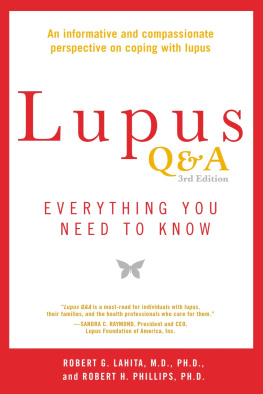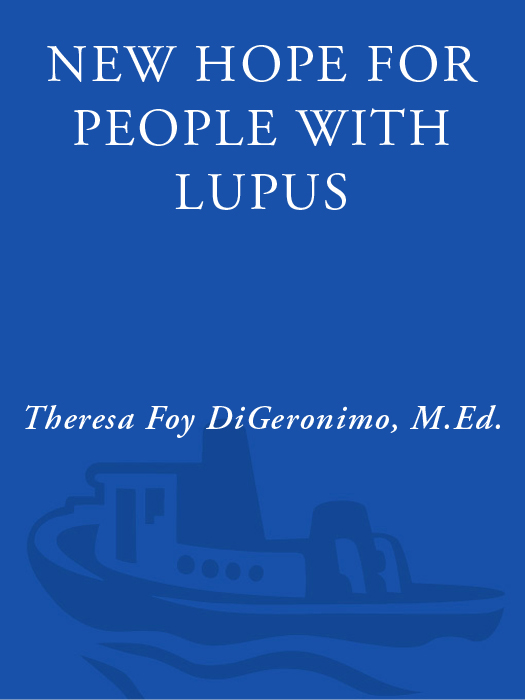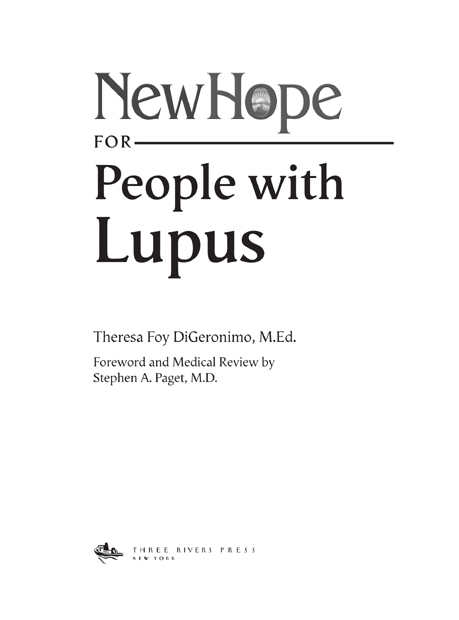Other Books in the New Hope Series
New Hope for Couples with Infertility Problems
New Hope for People with Alzheimers and Their Caregivers
New Hope for People with Bipolar Disorder
New Hope for People with Borderline Personality Disorder
New Hope for People with Depression
New Hope for People with Diabetes
New Hope for People with Fibromyalgia
New Hope for People with Weight Problems
Copyright 2002 by Prima Publishing, a division of Random House, Inc.
All rights reserved. No part of this book may be reproduced or transmitted in any form or by any means, electronic or mechanical, including photocopying, recording, or by any information storage or retrieval system, without written permission from Random House, Inc., except for the inclusion of brief quotations in a review.
Published by Three Rivers Press, New York.
Member of the Crown Publishing Group, a division of Random House, Inc., New York.
www.crownpublishing.com
THREE RIVERS PRESS and the Tugboat design are trademarks of Random House, Inc.
Originally published by Prima Publishing, Roseville, California, in 2002.
In order to protect their privacy, the names of some individuals cited in this book have been changed.
Interior design by Peri Poloni, Knockout Design
Illustrations by Laurie Baker-McNeile
Medical reviewer photo by Brad Hess
Library of Congress Cataloging-in-Publication Data
DiGeronimo, Theresa Foy.
New hope for people with lupus : your friendly, authoritative guide to the latest in traditional and complementary solutions / Theresa Foy DiGeronimo.
p. cm.(New hope)
1. Systemic lupus erythematosusPopular works. I. Title. II. Series.
RC924.5.L85 D544 2002
616.77dc21
2001055456
eISBN: 978-0-307-80921-6
v3.1
To all those who have shared
their stories of lupus in the
hope of helping others.
Contents
Foreword
A FTER CARING FOR people with lupus for nearly 30 years and being part of academic institutions searching for its causes and cures, such as Johns Hopkins, the National Institutes of Health, and the Hospital for Special Surgery, there are a few things that I can say for sure about the internal terrorist called lupus. There is not only hope, but also assurance that we will overcome this illness, just as we did polio, tuberculosis, and rheumatic fever. It is the most complex of disorders clinically, immunologically, and therapeutically, but it is not invincible and its secrets are there to be uncoveredand they will be. We have come a very long way and, although we still have a way to go, people with lupus should appreciate that while they are fighting the good fight against lupus in partnerships with their doctors, we are chipping away rapidly at its immunological core. While we work to unmask this unpredictable, waxing and waning, invisible, and stealthy illness, people with lupus, their families, and their doctors should work together to determine the best treatment approach for each individual. Until those major breakthroughs are announced, we must all dedicate our energies to making the lives of people with lupus the best and most fulfilling they can be by spreading the word about diagnosis and treatment to both patients and doctors. Our goal is nothing less than making sure that when it is present, lupus is immediately diagnosed and appropriately treated. Suffering for years without a diagnosis or being treated with medications without concern for their cumulative side effects is unacceptable in this age of modern medicine.
Thank goodness there is finally a comprehensive, up-to-date, and accurate resource for people with lupus. New Hope for People with Lupus brings to you the most modern concepts in lupus care and addresses, in one fell swoop, all of the important, scary, hard-to-understand aspects of lupus in a wonderfully readable and understandable form. It not only gives hope because it describes the many advances in our knowledge about and treatment of lupus, but it also enables you to be an informed consumer of medical care, appreciate the complexities of this systemic autoimmune disorder, and approach the disease head on. Use it as a friend, a guide, a consultant, and show it to your family, your friends, and your doctor. Knowledge gained from this book will move you from a state of fear, misunderstanding, insecurity, and dread to one that can, in close partnership with caring and knowledgeable physicians, improve your quality of life. It does so by helping you to maintain a well-balanced approach to this chronic illness, which in turn enables you to live a longer and happier life.
Lupus is a complex disorder to physicians and researchers in the field, so it is no wonder that it is so misunderstood by patients. It is also an invisible disorder, often missed by physicians for many years because it masquerades as many other illnesses. The patient is often diagnosed as having an infection, chronic fatigue syndrome, fibromyalgia, or even a psychological problem. This book allows you to become a central player in the collaborative diagnostic and therapeutic process that is what medical care is all about. It turns complex into understandable, fear into control, vagueness into solidity and a dark, ill-defined future into a more predictable one. With excellent and beautifully handled chapters on diagnosis, treatment, and other rarely addressed issues such as complementary care, nutrition, maintaining a job, sex, and depression related to having a chronic disorder, New Hope for People with Lupus allows you to take charge and move on with your life. It gives hope because there is hope, particularly after absorbing the pearls in this new partner in your medical care.
Stephen A. Paget, M.D.
Physician-in-Chief and Chairman of the Division
of Rheumatology at Hospital for Special Surgery,
New York; and the Joseph P. Routh Professor of
Medicine and Rheumatic Disease at Weill Medical
College of Cornell University
Acknowledgments
A DEBT OF gratitude and thanks is due to all the professionals who willingly shared their expertise to make this book as accurate and up-to-date as possible: Amy C. Brown, Ph.D., R.D., University of Hawaii, Honolulu; Michael Carroll, M.D., Center for Blood Research, Harvard Medical Center, Boston; Penny Cowan, American Chronic Pain Association, Rocklin, California; Katherine Fox, Davis, California; Anthony Gaspari, M.D., University of Maryland School of Medicine, Baltimore; Michael Gross, M.D., Fair Lawn, New Jersey; Helen Grusd, Ph.D., Los Angeles; Robert Hayden, Evanston, Illinois; Robert S. Katz, M.D., Presbyterian St. Lukes Medical Center, Chicago; Karen Kaufman, Fiskdale, Massachusettes; Robert P. Kimberly, M.D., University of Alabama, Birmingham; Celina Klee, The Upledger Institute, Palm Beach Gardens, Florida; Neil Kurtzman, M.D., Texas Tech University Health Sciences Center, Lubbock; Jimmy Lawrence, M.D., Nemours Clinic, Pensacola, Florida; Matthew Linnik, Ph.D., La Jolla Pharmaceutical, San Diego, California; Michael D. Lockshin, M.D., Hospital for Special Surgery, New York City; Kate Lorig, R.N., Dr.PH., Stanford Patient Education Research Center, Palo Alto, California; Edward J. Madara, M.S., American Self-Help Clearinghouse, Cedar Knolls, New Jersey; LindaSusan Markus, M.D., Wyckoff, New Jersey; Mary-Jo Myers, Pennsylvania School of Muscle Therapy, Oaks, Pennsylvania; Katina Rodis, Ph.D., Concord, Massachusettes; Gloria Spadaro, Lupus Foundation, Elmwood Park, New Jersey; Margrey Thompson, TheraCare Rehabilitation Companies, Murfreesboro, Tennessee; Ann Traynor, M.D., Northwestern University, Chicago; Ronald F. Van Vollenhoven, M.D., Ph.D., Karolinska Hospital, Stockholm, Sweden; Daniel Wallace, M.D., Wallace Rheumatic Center, Los Angeles; and John Yee, M.D., Veritas Medicine, Cambridge, Massachusettes.









